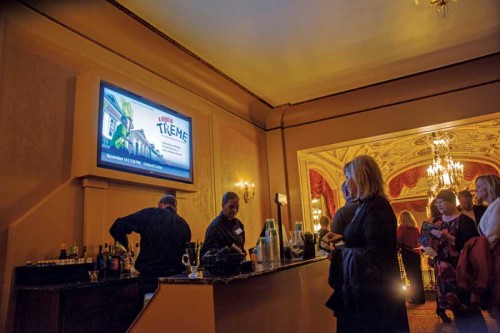
Photos courtesy Keywest Technologies
By David Little
Whenever communicating through the medium of digital signage, it is important to realize today’s viewers will not care about a message simply because it is digital in nature. The ‘cool’ factor of digital signage has long since worn off. There needs to be a better reason for them to be engaged.
Fortunately, digital signage has proven to be a strong platform for breaking out of old routines by experimenting with content. By having a bit of fun and jolting the audience with unexpected surprises, it can engage viewers well beyond a casual glance.
With the capability to change messages on the fly, based on scheduling, data or ‘environmental’ triggers, digital signage represents a new way to think about communications. Network managers are empowered to address the specific ways customers and employees think and behave in retail, transit and corporate facilities, to name a few. Digital signage is neither print nor TV and, as such, it requires a different approach.
Why content is important
With so much discussion of digital signage technologies, it is easy to overlook what the medium is all about in terms of getting actual results. Communications managers seek to add value to their businesses and, in the end, content is what delivers their strategy. And one of the most significant advantages of digital signage over other media is the ability to deliver on multiple strategies by changing content in opportune ways.
The ‘holy grail’ of digital signage has always been to deliver the right message at the right time to the right audience—i.e. relevance. Content can be designed to attract, engage and direct the attention of people at a point of decision, such as when they walk into a store.
The value of this goal has been well-established. According to a recent survey of quick-service restaurants (QSRs), for example, 30.8 per cent reported recouping their investment in digital menu boards (see page 40) within seven to 12 months, with an average five per cent sales lift for promoted food items and 20 per cent for beverages.

Fresh, dynamic content is important to catch people’s attention and engage them.
In a corporate setting, on the other hand, digital signage might be deployed in a lobby to welcome visitors as they arrive. In this context, the purpose is simply to build goodwill, but digital signage can also contribute to the ambience of interior décor.
In times of emergency, digital signage is particularly effective for sharing alerts sourced from third-party systems, such as the local police force. On-screen content can be co-ordinated with text alerts to provide up-to-the-second information to the public.
Similarly, in an industrial production plant, digital signage is well-suited for conveying safety information to large numbers of employees while they are actively working. Such communications can be vital in helping to maintain a safe and efficient facility.
Digital signage is in fact a significant opportunity for corporate communications, given 40 per cent of workers either do not have access to e-mail during the workday or do not read it in a timely fashion. Managers often rely on bulletin boards to get messages across, but the human brain is programmed to detect motion, so a more effective strategy is to place digital signs where employees take breaks, socialize and/or eat, using dynamic content to provide updates, reminders and any other messages of importance on any given day. Employee morale can also be improved by displaying contests, birthdays, other special events or the ‘employee of the month.’
Another purpose of corporate digital signage is to reduce the costs of training employees by scheduling and distributing educational videos across a network of screens. The medium has proven helpful in keeping staff informed of current corporate policies.
Making it stick
The term ‘sticky,’ as popularized on the Internet, refers to non-ad content that has the purpose of making users return to a site and will hold their attention for longer than just a glance. In digital signage, examples include news headlines, weather forecasts and contests.
Sticky content is important because ads—and some other types of digital signage content—are not engaging in themselves without the proper context. The idea is to piggyback one type of content onto another to yield greater overall value. People want to be informed and entertained, so digital signage should embrace the kind of mix that makes a media channel popular.
TV, by way of example, is good at informing and entertaining while also advertising. Simply recreating a TV channel on a public screen, however, will not automatically attract an audience. Rather, digital signage needs to cut through the ‘noise’ and deliver powerful messages that otherwise might be ignored.
Many of today’s professional media syndicators make it easy to incorporate sticky content through live streaming. Some even develop custom playlists with a mix of content that is specifically relevant to a given digital signage network’s audience.

In many cases, updated content can be imported from databases and other sources, as for this digital sign at a theatre’s bar area.
While syndicated content is highly desirable for the above reasons, however, it is important to beware of overusing it for fear of squandering the network’s core communications strategy. If too much sticky content is displayed, the core messaging can become diluted.
Instead, the mix should also incorporate fresh content focusing on the organization’s core communications efforts. The right balance of information sources will depend on the type of business, but once established, it will keep viewers coming back.





